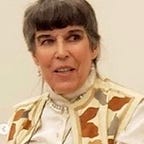Machine Learning for Fashion Clothing is Useless
Curves representing the body in Machine Learning (FashNerd) are no help to Pattern Engineers — But, Triangulation of a Dress Foundation gives amazing help to both Designers and Pattern Engineers
The purpose of the cardboard was to get the 3D form of the Dress Foundation by triangles only — which are very simply computerized. Curves are very complicated mathematics to enter into a computer. Every time my brother Donald needed another triangle for the computer, I would fold the cardboard at strategic points to give him that triangle. By strategic, I mean it would be at an area that could be used as a nice and useful design line in a dress or clothing.
Flora Miranda “explains the process of teaching a machine what clothing is and how it is produced. … Each design from the SS19 range of the collection plays with feminine body shape. … Her approach allowed her to explore ‘Machine Learning’ … Her latest collection explores how fashion will evolve in the next 10 years, while inspiring others to develop, innovate and rethink fashion, ‘especially, because intelligent machines are the base of modern production processes.”
[Note: As a Pattern Engineer and Production Engineer in fashion clothing, I know this to be false. Intelligent machines will never master both creativity and intellect — both necessary for fashion designers and apparel manufacturers. In my paper for the American Society of Mechanical Engineers Technical Design Conference, 1990, Chicago Illinois, “Syntax and Semantics of an Image Communication Language for Design Management” I talked of wearing two hats- creative and technical — but not at the same time.
Triangulation is the natural engineering process that satisfies both design ideas and computerization of 2D/3D processes. The body has too much unnecessary information and collecting all that shows again in much machine learning quantity is not quality. Rather, the approach is first the quality lines and triangles useful for the creative designer, and that are flattering for the wearer. Second is the planning of 2D/3D computerization and pattern engineering. This information is now far more useful and higher quality.
A great tool for making curves in pattern work is the Tailor’s Curve. I bought my metal one with the Tailor’s Square in the 1950s at a Tailor’s shop. The Tailor’s Curve is excellently engineered with the edge slowly getting more curved as it measures further on. We have a beautiful curve for every purpose. Let’s never leave out the beautiful and useful technology engineered in the past, for the present gawdy, useless stuff for media presentation.
I used the Foundation Dress and developed Nine Primitive 3D Forms and 3D Flats. They were presented in my NSF-SBIR #9161096 grant award, “A 3-D/4-D Computerized Model for Human-Machine Integration in Apparel Manufacturing Engineering” in 1992, Stylometrics: Linking style creation and pattern engineering images in databases.
In 2005 I went back to teaching and mentoring, and evolved the Foundation Dress into four Templates, for easy pattern usefulness to my fashion design students and proteges.
The Templates were illustrated by some of my styles from past collections: 1.Polo Dress; 2. Chemise, front and back: 3. Sunburst Dress using the Empire Template. They are now in the MassArt (Massachusetts College of Art & Design) Fashion Design Museum Archive, and their 2022 Fashion Design Catalog.
Thank you for reading, and I hope you have learned something about the art and science in fashion design by combining creative design and pattern engineering. When I graduated from MassArt in 1955, my thesis was “Fashion: An Art and A Science”
